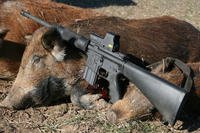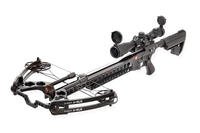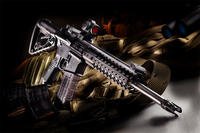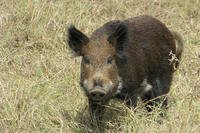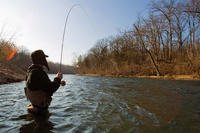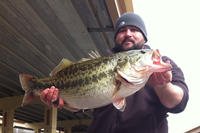Slug hunters have more options than simply dragging their turkey gun into the deer woods. Check out a few options built specifically for deer hunting.
by Ralph M. Lermayer
"Shotgun slugs are a fact of life, and as our populations expand, their mandated use is sure to grow."
I don't know of anyone who actually enjoys shooting slugs, yet 35 percent of the whitetail hunters nationwide are mandated to use them. The big, heavy, slow-moving chunks of lead like the early Brenneke and Foster styles are thought to be safer in populated areas because an errant shot won't travel far. This short-range limitation doesn't really bother most slug hunters because, in slug country, most bucks are killed inside of 75 yards, and within that range, solid chunks of lead fired from a smoothbore work just fine.
While the "Punkin Ball" reputation hangs on, it is no longer 100-percent accurate. Modern technology has revved up the slug world with the application of polymer sabots, and these hot-rod members of the slug world are moving higher-ballistic-coefficient bullets accurately downrange at up to 2,000 fps. That takes them squarely into centerfire territory.
The Players
We could fill this entire magazine discussing the different slug options available today. Remington offers their solid copper sabot options and their super-accurate BuckHammer for smoothbores. Winchester, Federal, Lightfield, Brenneke and Foster, among others, provide a huge menu of options for 12 -and 20-gauge shotguns. The choices are vast, so let's accept the fact that whatever style of slug you prefer, it's available. But how do we set up to make them shoot to the best of their potential? What does it take on the gun end to get the best performance from today's slugs?
Aftermarket Barrels
Many hunters simply start running full-bore slugs through their upland or duck guns. All they can do to improve the accuracy is play with choke options and different slugs, but other than that, what you get is all there is. If that setup delivers a 12-inch group at 50 yards, you don't pull the trigger unless the shot is close. This approach does have its fans, but most serious deer hunters in slug country want more than that.
Aftermarket barrels set up for optical sights and rifled with a slug-friendly twist are available from every major shotgun manufacturer. Sources like Hastings or Cabela's can set you up for just about any make or model. Pick an optic or bright metallic sight, drop the barrel in, find a sabot it prefers, and you're good to go. It's a safe bet most shotgun deer hunters don't go any further than that, and they usually get their buck in the truck. There are, however, some other simple steps you can take to wring a lot more accuracy out of that basic setup.
Interchangeable barrels are, by necessity, a loose and sloppy fit. Shotguns triggers are coarse affairs, usually heavy, creepy and rough. Neither are conducive to accuracy, but a trip to a gunsmith can do wonders. Barrels can be pinned in place by drilling and tapping a small hole through the receiver where the barrel connects. A small setscrew is inserted and tightened, locking the two together and taking a lot of the slop out. When you switch back to your field barrel, just remove it. This simple fix will deliver a dramatic improvement in aftermarket barrels.
While it's in the shop, a decent gunsmith can do a lot to smooth up the trigger. Perform these two simple fixes and the improvement in accuracy will amaze you.
The Dedicated Slug Gun
Through the years, many manufacturers have offered dedicated bolt-action slug guns, or in the case of the Ithaca Deerslayer II, a dedicated pump. Of all the choices, these make the best slug guns. Unfortunately, most have been discontinued, but if you hunt hard on the Web or used gun racks, you can turn them up. Of course, firms like Tar Hunt can build you one that will shoot like a rifle, and that's unquestionably the best of all options. It is a pricey option and not for everyone, but any way you can put together a bolt-action slug shooter with a rifled bore will allow you to get all you can from any slug.
The Single Shots
You can build a dedicated slug setup with a great optical platform and a good trigger without spending a lot of your hard-earned money. Both Thompson/Center and H&R (New England Firearms) offer a rifled slug barrel for their single-shots. I have one of each. Both will keep all their shots within 2 ½ inches at 100 yards with Winchester Supreme saboted slugs. The fact that you can also get a turkey barrel, a muzzleloader barrel and a centerfire barrel to fit the same receiver is just icing on the cake. Other manufacturers like Mossberg and a slew of imports have a rifled slug barrel in their lineup.
The basic Handi Rifle from H&R offers a package including a rifled slug barrel. If you have an existing frame you will have to ship it to the factory (now in Ilion, N.Y.) for fitting and proper headspacing, but you'll wind up with a surprisingly accurate result. Someday the value and performance in this humble single-shot will be discovered, but right now they are common and inexpensive on the used rack.
T/C's Encore is another way to build a tack-driving slug option. With the T/C frame, no fitting is required, just order the barrel and fore-end, drop it in and go.
Shotgun slugs are a fact of life, and as our populations expand, their mandated use is sure to grow. On the flip side, they will get you into some of the finest whitetail hunting available anywhere. Many past and current record-book whitetails have met their demise from a well-placed shotgun slug. If you're going to hunt with them, you might as well set up a rig that shoots slugs as accurately as possible.

